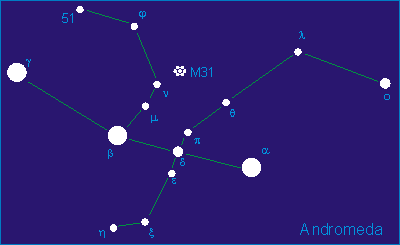
Zeta Andromedae
Encyclopedia
Zeta Andromedae (Zeta And, ζ Andromedae, ζ And) is a star system
in the constellation
Andromeda
. It is approximately 181 light years
from Earth
.
Zeta Andromedae is an eclipsing spectroscopic binary whose primary is classified as an orange K-type
bright giant
with a mean apparent magnitude
of +4.08. In addition to brightness variation due to eclipses, the system is also an RS Canum Venaticorum type
or Beta Lyrae type
variable star
. Its brightness varies from magnitude +3.92 to +4.14 with a period of 17.77 days. The orbital period of the binary is 17.77 days.

to the eclipsing binary have been observed. B has common proper motion
with A, but C and D are probably optical.
Star system
A star system or stellar system is a small number of stars which orbit each other, bound by gravitational attraction. A large number of stars bound by gravitation is generally called a star cluster or galaxy, although, broadly speaking, they are also star systems.-Binary star systems:A stellar...
in the constellation
Constellation
In modern astronomy, a constellation is an internationally defined area of the celestial sphere. These areas are grouped around asterisms, patterns formed by prominent stars within apparent proximity to one another on Earth's night sky....
Andromeda
Andromeda (constellation)
Andromeda is a constellation in the northern sky. It is named after Andromeda, the princess in the Greek legend of Perseus who was chained to a rock to be eaten by the sea monster Cetus...
. It is approximately 181 light years
Light Years
Light Years is the seventh studio album by Australian recording artist Kylie Minogue. It was released on 25 September 2000 by Parlophone and Mushroom Records. The album's style was indicative of her return to "mainstream pop dance tunes"....
from Earth
Earth
Earth is the third planet from the Sun, and the densest and fifth-largest of the eight planets in the Solar System. It is also the largest of the Solar System's four terrestrial planets...
.
Zeta Andromedae is an eclipsing spectroscopic binary whose primary is classified as an orange K-type
Stellar classification
In astronomy, stellar classification is a classification of stars based on their spectral characteristics. The spectral class of a star is a designated class of a star describing the ionization of its chromosphere, what atomic excitations are most prominent in the light, giving an objective measure...
bright giant
Bright giant
The luminosity class II in the Yerkes spectral classification is given to bright giants. These are stars which straddle the boundary between giants and supergiants, and the classification is in general given to giant stars with exceptionally high luminosity, but which are not sufficiently bright...
with a mean apparent magnitude
Apparent magnitude
The apparent magnitude of a celestial body is a measure of its brightness as seen by an observer on Earth, adjusted to the value it would have in the absence of the atmosphere...
of +4.08. In addition to brightness variation due to eclipses, the system is also an RS Canum Venaticorum type
RS Canum Venaticorum variable
RS Canum Venaticorum variables are a type of variable star. They are close binary stars having active chromospheres which can cause large stellar spots. These spots are believed to cause variations in their observed luminosity...
or Beta Lyrae type
Beta Lyrae variable
Beta Lyrae variables are a class of close binary stars. Their total brightness is variable because the two component stars orbit each other, and in this orbit one component periodically passes in front of the other one, thereby blocking its light. The two component stars of Beta Lyrae systems are...
variable star
Variable star
A star is classified as variable if its apparent magnitude as seen from Earth changes over time, whether the changes are due to variations in the star's actual luminosity, or to variations in the amount of the star's light that is blocked from reaching Earth...
. Its brightness varies from magnitude +3.92 to +4.14 with a period of 17.77 days. The orbital period of the binary is 17.77 days.
Location
This star's location in the constellation Andromeda can be seen in the following diagram:
Components
A number of visual companionsDouble star
In observational astronomy, a double star is a pair of stars that appear close to each other in the sky as seen from Earth when viewed through an optical telescope. This can happen either because the pair forms a binary star, i.e...
to the eclipsing binary have been observed. B has common proper motion
Proper motion
The proper motion of a star is its angular change in position over time as seen from the center of mass of the solar system. It is measured in seconds of arc per year, arcsec/yr, where 3600 arcseconds equal one degree. This contrasts with radial velocity, which is the time rate of change in...
with A, but C and D are probably optical.
External links
- Zeta Andromedae at Alcyone Software's Star Data Pages
- Image ζ Andromedae

